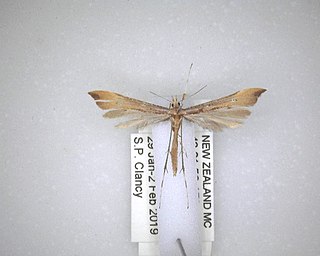
Amblyptilia heliastis is a moth of the family Pterophoridae. This species is endemic to New Zealand. It was first described by Edward Meyrick in 1885. The larvae of this species feed on Veronica species. The adults of this species are on the wing from October to February and can often be found amongst subalpine Veronica species.
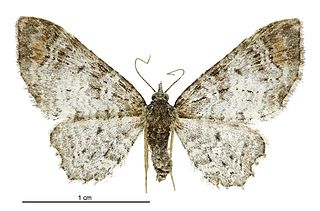
Pasiphila aristias is a species of moth in the family Geometridae. It was described by Edward Meyrick in 1897 and is endemic to New Zealand. This species is found in both the North and South Islands and inhabits subalpine and native forest. Adults are on the wing in December and January and are attracted to light.

Chersadaula ochrogastra is a species of moth in the family Oecophoridae. This species is endemic to New Zealand. It is classified as "Data Deficient" by the Department of Conservation.
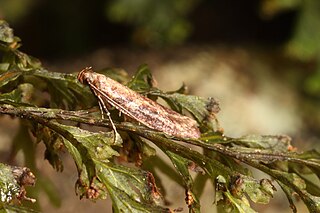
Cadmogenes is a genus of moths of the family Plutellidae. It contains only one species, Cadmogenes literata, which is found in New Zealand. This species is endemic to New Zealand. It has been classified as "Not Threatened" by the Department of Conservation.
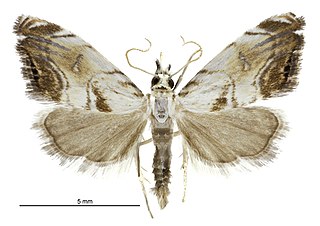
Glaucocharis harmonica is a moth in the family Crambidae. This species was described by Edward Meyrick in 1888. It is endemic to New Zealand and is found in the North and South Islands. It inhabits lowland to subalpine native forest. It has been hypothesised that there are two broods per year. The larval hosts are unknown. Adults are on the wing from October until January.
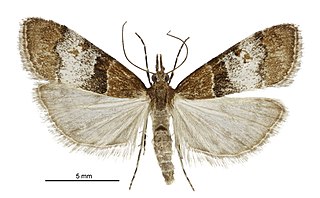
Antiscopa acompa is a moth in the family Crambidae. It was first described by Edward Meyrick in 1884. It is endemic to New Zealand and is found both the North and South Islands. The species inhabits native forest and adult moths are attracted to light.
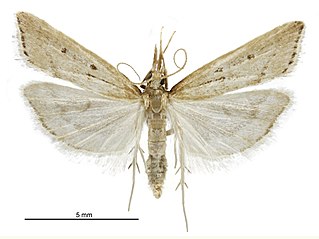
Antiscopa elaphra is a moth in the family Crambidae. It is endemic to New Zealand and has been observed in both the North and South Islands. Adults of this species are on the wing from August until March and are attracted to light. In 2020 this species had its DNA barcode sequenced.
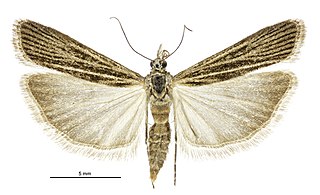
Eudonia atmogramma is a moth in the family Crambidae. It was described by Edward Meyrick in 1915. It is endemic to New Zealand.

Kiwaia hippeis is a moth in the family Gelechiidae. This species was first described by Edward Meyrick in 1901. It is endemic to New Zealand and has been collected in Christchurch. Adults of this species are on the wing in December and are attracted to light.

Asaphodes cosmodora is a species of moth in the family Geometridae. This species is endemic to New Zealand and has been observed in the South Island. The adults of this species are on the wing in January and February.

Asaphodes dionysias is a species of moth in the family Geometridae. This species is endemic to New Zealand and is only known from mountainous areas in Central Otago. It lives in open grassy mountainous habitat at altitudes up to 1750 m. It is also known to live in wetland habitat. The larvae of this species feed on native herbs. The adults of this species are on the wing in January and February. The adult female of the species has reduced wing size in comparison to the male.

Tingena ancogramma is a species of moth in the family Oecophoridae. It is endemic to New Zealand and has been found in the Hen and Chicken Islands, the North Island and the South Island. Adults are on the wing in summer and autumn and inhabit open areas of forest scrubland.

Tingena chloritis is a species of moth in the family Oecophoridae. It is endemic to New Zealand and has been found in the South Island. Larvae of this species feed on leaf litter. The adults of this species are light flyers and are attracted to light.

Tingena eumenopa is a species of moth in the family Oecophoridae. It is endemic to New Zealand and found in the North and South Islands. The adults have been found amongst tree ferns and are on the wing in December.

Tingena horaea is a species of moth in the family Oecophoridae. It is endemic to New Zealand and have been observed in both the North and South Islands. The adults are on the wing in January.

Asaphodes nephelias is a moth in the family Geometridae. It is endemic to New Zealand and has been observed in the South Island. The preferred habitat of this species is alpine tussock grasslands above native forest and in wetlands. The adults of this species are on the wing from January to March and are day flying. The female has brachypterous wings.

Asaphodes prymnaea is a moth in the family Geometridae. It is endemic to New Zealand and can be found on the Mount Arthur tableland. It is common in limestone valleys. The female of the species is paler and has less distinctive markings than the male. Adults are on the wing in January and February.

Asaphodes sericodes is a moth in the family Geometridae. It is endemic to New Zealand and has been observed in the southern parts of the South Island. This species inhabits open tussock grasslands in subalpine scrub or wetlands. The female of the species is likely semi-apterous and is flightless. The adult males are on the wing in January.
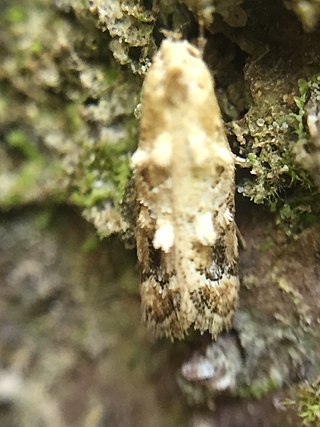
Trachypepla aspidephora is a species of moth in the family Oecophoridae. It is endemic to New Zealand and has been observed in the North and South Islands. Adults are on the wing from November to March and are attracted to light. The moths can be found resting on tree trunks where their colouration imitates lichens.

Trachypepla photinella is a moth of the family Oecophoridae first described by Edward Meyrick in 1883. It is endemic to New Zealand and has been collected in Wellington, Wainuiomata, D'Urville Island and Christchurch. The preferred habitat of this species is native forest and adults are on the wing from December until February.




















